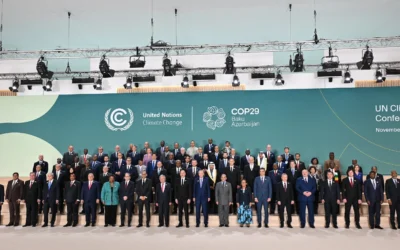Greenly study reveals how defence spending surge could undermine EU climate goals
As European countries pour hundreds of billions into tanks, jets, and military infrastructure under the €800 billion ReArm Europe initiative, a new report warns that the continent’s defence spending spree may come at a steep climate cost.
The report, published by Paris-based carbon accounting firm Greenly, reveals that military activities now represent a major but largely invisible contributor to global emissions. In an interview with Climate Solutions News, Greenly CEO Alexis Normand said, “We fully recognise the importance of investing in defence. But environmental commitments must not be neglected – and the current exclusion of defence emissions is deeply concerning.”
The cost of security
ReArm Europe is the EU’s answer to a shifting geopolitical landscape, including growing threats on its eastern borders and waning security guarantees from the United States. Member states are boosting defence budgets at a pace not seen since the Cold War.
But behind the new procurement plans lies a quieter reality: militaries are some of the most carbon-intensive institutions on the planet. According to Greenly’s estimates, NATO military spending in 2024 reached $1.47 trillion, generating approximately 256 million tonnes of CO₂e – more than the total emissions of Spain or Thailand.
EU NATO members alone accounted for 79.5 million tonnes in 2024 and are projected to hit 81.1 million tonnes in 2025. And the ReArm Europe initiative, worth €800 billion, is expected to result in an additional 150.3 million tonnes of CO₂e, equivalent to the entire annual emissions of the Netherlands.
Why are military emissions invisible?
So why don’t we hear more about this? One reason is that defence emissions are largely exempt from international climate rules. “Military emissions are not just underreported – they’re often not reported at all,” said Normand. “International agreements like the Kyoto Protocol and the Paris Agreement made this voluntary, citing national security.”
In practice, this has allowed most governments to avoid disclosing how much carbon their armed forces emit. Even among NATO allies, only a handful – such as the UK and Germany – include military emissions in national carbon inventories. The result is what many researchers now call the “military emissions gap.”
Greenly’s report draws on a methodology using an average emissions factor of 174 million tonnes of CO₂e per $1 trillion in military spending, based on 2023 NATO figures. This ratio includes operational emissions (fuel, bases, training), supply chain emissions, and embodied carbon in procurement.
Carbon-heavy equipment
Modern militaries run on fossil fuels. Fighter jets, warships, tanks, and even military bases consume enormous amounts of energy – often from the dirtiest sources. An F-35 fighter jet, for example, burns about 5,800 litres of fuel per flight hour, emitting 15 tonnes of CO₂e – roughly equivalent to the average annual emissions of one American citizen.
Manufacturing military equipment is also highly carbon-intensive. “Materials like aluminium, steel, titanium, and carbon composites all have high embodied emissions,” said Normand. “And modern weapons systems use lots of them.”
The F-16, for instance, is made from more than 78% aluminium, which emits between 6.8 and 20 kg CO₂e per kilogram produced. Carbon fibre composites emit up to 24 kg CO₂e per kilo. The report also highlights that complex global supply chains – such as those for the F-35, built across multiple continents – add further emissions from logistics and transport.
A new emissions frontier
The numbers are staggering. But they don’t even include emissions from active conflicts or post-war reconstruction, which Greenly notes are “far higher but outside the scope” of this analysis. If these were included, the military’s climate impact would be even greater.
Globally, militaries and their supply chains are estimated to produce 5.5% of total greenhouse gas emissions – more than all of Africa (3.7%) and more than the global aviation and shipping industries combined.
And yet, military emissions are not capped, not taxed, and not subject to binding reduction targets.
That, says Normand, needs to change. “If we don’t integrate defence into climate strategy,” he says, “Europe risks locking itself into a high-emissions model for decades. We’re still seeing greenhouse gas levels rise when they should be falling. This is no time for blind spots.”

Political momentum at risk
Some modest progress has been made. NATO recently published its first climate strategy, aiming for a 45% reduction in military emissions by 2030. The European Parliament has called for an end to the military emissions loophole. And several EU countries have begun developing green procurement policies for defence.
But with Donald Trump’s return to the White House and the US signalling a retreat from climate leadership, that momentum could stall.
“Trump’s lack of interest in climate policy could seriously jeopardise the U.S. military’s engagement on emissions,” said Normand. “And if Europe follows suit, it would send the wrong signal.”
The fear is that climate reforms will be sidelined as a “peacetime luxury,” just as defence budgets balloon. Greenly warns that unless environmental oversight is urgently embedded in Europe’s defence strategy, it could derail progress on the EU’s legally binding Fit for 55 targets.
What could be done?
Greenly outlines several clear steps:
- Mandatory military emissions reporting under EU climate law
- Binding reduction targets aligned with national and European decarbonisation plans
- Green procurement policies, prioritising low-carbon materials and technologies
- Electrification of non-combat fleets, including logistics and support vehicles
- Renewable energy integration at bases, such as solar panels and heat pumps
“None of this is impossible,” said Normand. “But it requires political will. We need to stop treating defence as separate from climate – and start building a security strategy that’s compatible with the carbon budget.”
Prefer to listen to the full interview with Greenly Founder and CEO, Alexis Normand? Check out the podcast version here or via Spotify, Apple Podcasts or Amazon.
The cost of missed opportunities
The report also highlights the opportunity cost of unchecked defence spending. NATO’s 2023 military budget of $1.34 trillion, for example, could fund the entire global $100 billion per year climate finance commitment to developing countries for over 13 years.
The EU’s €800 billion defence package alone could alternatively pay for 5.7 million electric buses or 43 million home solar systems.
“Rearmament might be necessary for security,” said Normand, “but that doesn’t mean we should ignore the emissions. These choices have consequences, and they should be part of the climate conversation.”
Read Greenly’s full report, Rearming Europe: Counting the Carbon Bootprint, at greenly.earth.




